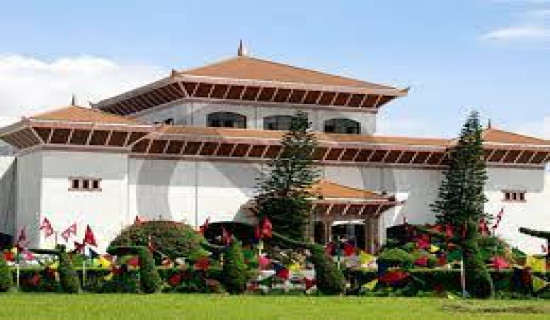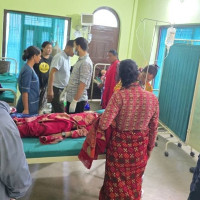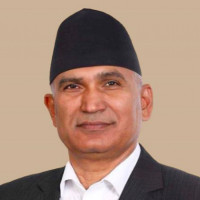- Friday, 29 August 2025
Shooting Tigers With Cameras
The country's top wildlife photographer, Chungba Sherpa, arrives in the Bardiya National Park before eight o'clock. He spends the day in a Land Rover with a guide at the park's prime tiger viewing location. Around 6:00 p.m., they return excited.
He visits the park in the morning, as does American wildlife photographer Jocelyn Stokes, who wants to film the tigers. She walks about with the camera ready and maintains a camera with a 600mm lens mounted on a tripod on the back of a pickup truck. More than ten wildlife photographers and photojournalists, including four foreigners, are currently prowling the woodlands around Bardiya in an effort to shoot the tiger. The presence of tigers is a sign of a clean and healthy ecology. Tigers are thought to contribute to the smooth and wholesome operation of the forest's life cycle.
This is an appropriate season to visit this park to watch and take photographs of Royal Bengal Tigers. For this reason, a large group of local, national, and international wildlife photographers and photojournalists are present to capture tigers. A contest is being held to capture images and videos of tigers. Now, their daily routine resembles a jungle.
Tiger Attack
A tiger attacked two ladies who were collecting firewood in Madhuvan-5, the Chiraute community forest of Bardiya, a few weeks ago. Suddenly the villagers were irate. In the last four years, there have been 18 fatalities in the Khata Biodiversity Corridor and the intermediate zone of Bardiya. This indicates that the villagers have a more unfavourable than positive opinion of the tiger. But, now renowned wildlife filmmakers, photographers, and photojournalists from various locations in Nepal and America have gathered to Bardiya to capture images and films of the same tiger.
Famous Nepalese wildlife photographer Rajesh Dhungana, who works with the American International News Service, is now extremely ecstatic. "He claimed, "I visited Bardiya eight times over the course of three years, and I've never been able to shoot such excellent pictures as now. Six tigers, he said, were spotted by him in just 11 days. A tiger was spotted by him six times outside the park, but just once within.
Throughout the park, there was a lot of congestion. Because of this, tigers are more prevalent in the intermediate areas. Photographing tigers necessitates a little amount of danger. Khata is sitting in the ecological corridor's risk zone and snapping images for this reason. There is a great deal of anxiety and terror, he continued. "Pictures are fantastic to capture." He reported having a tiger for 27 minutes. He recalled having the most enduring delight of his life at that time while capturing a great deal of fascinating, distinctive, and thrilling photos. The tiger is seen resting on the riverbank and the road in this incredible photo. Photographs have been taken of tigers of all ages.
According to him, he took 390 photos within the park and 1954 outside. A tiger similar to him was spotted 20 times in 8 days, which excited wildlife photographer and videographer Jocelyn Stokes. She expressed how thrilled she was to capture stunning and captivating footage. She claimed that despite her great anxiety and dread, she managed to get a nice video.
She claimed, "We had meant to do a documentary, and we were successful.
"The documentary will be aired after six months. She said that this will offer prompt assistance in promoting tourism in Nepal. She works as a naturalist in Aloiston National Park in America and claims to have seen tigers five times in the river. She also claims to have captured an exciting audio clip of a tiger enjoying the water.
She was disappointed when she didn't see a tiger the first day and decided to make a video the next day, seeing three distinct tigers seven times. The stunning sight of the male and female tigers together at six o'clock on the ninth day, according to her, cannot be adequately described.
In three days, photographer Sherpa spotted the tiger twice. He claimed that seeing the tiger in the river and on the hill had him giddy with anticipation.
Photographers visiting this park were overjoyed as well. Like him, renowned American wildlife photographer Peter Mangolds was having fun capturing images of tigers. He claimed to have taken a photo of a tiger encounter at a distance of 4 feet.
Chandrasekhar Karki, a top photojournalist for Nepal, was also spotted in Bardiya watching the tigers. He said that he was overjoyed to capture the first-ever photograph of a tiger in Bardiya. In three days, he claimed to have seen three tigers. The act of taking photos and movies was quite enjoyable.
Tiger habitats are situated in verdant forests, and the water bodies there are clean and healthy. There is access to nourishing food. Diseases do not affect quadrupedal animals in the wild. Drinking pure spring water can help keep people healthy. Dr. Hemsagar Baral, a tiger environmentalist, stated: "The tiger makes the ecology balanced, hence it is the friend of farmers also.""
Bardiya Park now has twice as many tigers as it had in 2010. A summit of the leaders of the 13 nations where tigers are present was convened in Russia in November 2011. The summit predicted that by 2022, or 12 years from now, there should be twice as many tigers living in their native environment.
Since 2010, the number of tigers in Bardiya Park has doubled. In November 2011, a conference of heads of government of 13 countries where tigers are found was held in Russia. The conference announced that within 12 years i.e. by 2022, the number of tigers in the natural habitat should be doubled.
In 2010, there were 18 tigers in Bardiya National Park. According to 2018 count, 87; and in 2022, it has reached 125. In 2011, there were 121 tigers in Nepal, in 2022 the number has reached 355.
Though Chitwan National Park has the greatest number of tigers, cameramen, however, think that Bardiya is a favourable location to watch and shoot tigers in their natural environment.
(Paudel is a wildlife photojournalist)









-original-thumb.jpg)







